Deadlock Detection In OS
In the last lecture, we covered Deadlock Prevention and Avoidance. In this lecture, we will see Deadlock Detection in OS. Deadlock detection can be explained in two ways:
- When resources have a single instance
- When resources have multiple instances
So, to cover Deadlock detection, we first have to understand the concept of a resource allocation graph. Because a Deadlock can be detected through the resource allocation graph.
What Is a Resource Allocation Graph?
The resource allocation graph provides the entire information about all those processes which are holding some resources or waiting for resources. If there is a single instance resource in the cycle and circular wait exist then deadlock must be there.
Any resource in the cycle may have more than one instance. Each instance of resource in cycle is represented by a dot inside the rectangle.
How Wait for Graph is Derived?
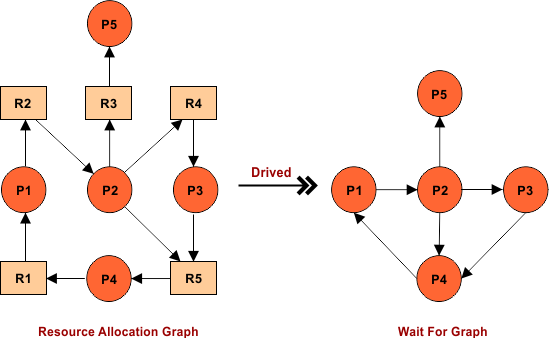
P1 will complete when it gets resources R1 and R2, given is resource allocation Graph. R1 is already allocated to P1, but R2 is given to P2. So P1 is dependent on P2, shown in wait for graph P1 — >P2. Because when P2 executes then it will free the allocated resource R2. In the same way P2 will get executed when it gets resources R3, R4 and R5. R3 is taken by P5, R4 is taken by P3 and R5 is taken by P3. So, P2 is dependent on P3, P4 and P5. In the same way P3 is dependent on P4. Because P4 reserved the resources required to P3. P1 reserved the resources required to P4 so, P4 is dependent on P1.
Resource Allocation Graph Vs Wait for Graph
If the is a cycle in wait for graph then there must be deadlock but if there is cycle in resource allocation graph then there may or may not be a deadlock.
Components of Resource Allocation Graph
There are two main components of resource allocation graph
i. Vertices
The sub-components of Vertices are Process vertex and Resource Vertex. The resource vertex
is further categorized into Single instance Resource and multi instance resource.
ii. Edge
Edge is also known as arrow. Edge is further categorized into Reguset edge and assign edge
detail diagram of components of resource allocation graph is given under
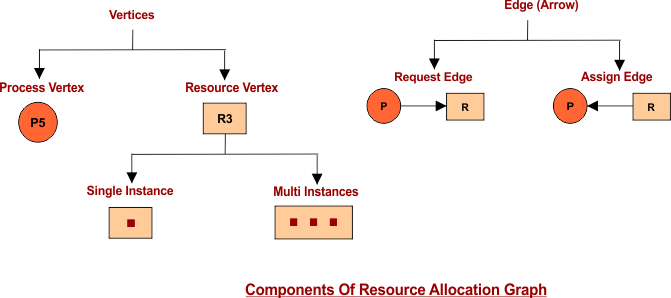
Through Resource allocation graph we can find the followings:
- Deadlock occurrence or not?
- Sequence?
- In the end, current available resources?
Now let’s explain deadlock detection through its methods:
1. When Resources Have a Single Instance
If CPU is the Resource and our system having only one CPU, then it will be single instance Resource. In the same way, If Printer is the resource and we have only one printer, then it is an example of single instance resource.
Keep in mind, If there is a cycle in resource allocation graph and all resources are single instance in that cycle then there must be a deadlock in processes.
Question 01: Look at Resource allocation graph given below and find weather a deadlock present or not?
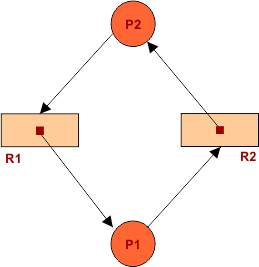
To find the deadlock in the resource allocation graph, there is a best way called a resource allocation table. Explanation is given under.
| Process | Allocated R1 | Allocated R2 | Request R1 | Request R2 |
|---|---|---|---|---|
| P1 | 1 | 0 | 0 | 1 |
| P2 | 0 | 1 | 1 | 0 |
-
P1 is holding R1 and waiting for R2
-
P2 is holding R2 and waiting for R1
Available Resources
| R1 | R2 |
|---|---|
| 0 | 0 |
So, Deadlock is confirmed because P1 is dependent on P2 and vice versa. But no resource is available. There were two resources, and both of these were used.
Question No: 02
Look at the Resource allocation graph in the diagram. And find whether the deadlock is there or not. and if there is no deadlock, then find the safe sequence.
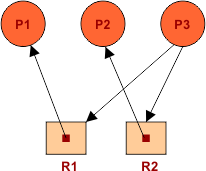
Resource Allocation and Request Table
| Process | Allocated R1 | Allocated R2 | Request R1 | Request R2 |
|---|---|---|---|---|
| P1 | 1 | 0 | 0 | 0 |
| P2 | 0 | 1 | 0 | 0 |
| P3 | 0 | 0 | 1 | 1 |
| Step | Availability (R1, R2) | Executed Process |
|---|---|---|
| 1 | (0, 0) | Before execution |
| 2 | (1, 0) | P1 executed, released R1 |
| 3 | (1, 1) | P2 executed, released R2 |
| 4 | (1, 1) | P3 executed (had enough) |
Safe Sequence will be P1 –> P2 –> P3. No deadlock because all processes are executed successfully.
Note: Availability (0, 0) can be check from diagram as two resources and taken by some processes. When one process execute then its resources are taken back and availability of resources increased.
2. When resources have multiple instances
Question No: 01
Find whether the deadlock is there or not. and if there is no deadlock, then find the safe sequence. The resource allocation graph for this question is given below
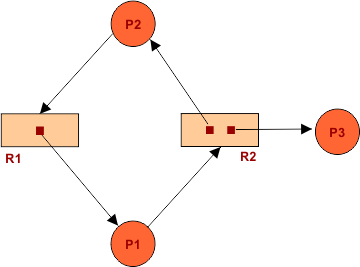
Resource Allocation and Request Table
| Process | Allocated R1 | Allocated R2 | Request R1 | Request R2 |
|---|---|---|---|---|
| P1 | 1 | 0 | 0 | 1 |
| P2 | 0 | 1 | 1 | 0 |
| P3 | 0 | 1 | 0 | 0 |
Availability and Execution Sequence
| Step | Availability (R1, R2) | Executed Process |
|---|---|---|
| 1 | (0, 0) | Before execution |
| 2 | (0, 1) | P3 executed, released R2 |
| 3 | (1, 1) | P1 executed, released R1 |
| 4 | (1, 2) | P2 executed, released R2 |
Safe Sequence will be P3 -> P1 -> P2. No deadlock because all processes are executed successfully.
Question No: 02
The resource allocation graph is given in the diagram. Find deadlock is there or not? and if there is no deadlock, then find the safe sequence.
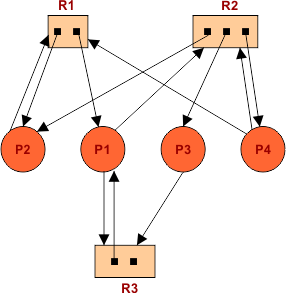
Resource Allocation and Request Table
| Process | Allocated R1 | Allocated R2 | Allocated R3 | Request R1 | Request R2 | Request R3 |
|---|---|---|---|---|---|---|
| P1 | 1 | 0 | 1 | 0 | 1 | 1 |
| P2 | 1 | 1 | 0 | 1 | 0 | 0 |
| P3 | 0 | 1 | 0 | 0 | 0 | 1 |
| P4 | 0 | 1 | 0 | 1 | 2 | 0 |
Availability and Execution Steps
| Step | Availability (R1, R2, R3) | Executed Process |
|---|---|---|
| 1 | (0, 0, 1) | Before execution |
| 2 | (0, 1, 1) | P3 executed, released R2 |
| 3 | (1, 1, 2) | P1 executed, released R1, R3 |
| 4 | (2, 2, 2) | P2 executed, released R1, R2 |
| 5 | (2, 3, 2) | P4 executed, released R2 |
The safe sequence will be P3 -> P1 -> P2 -> P4. After execution, all resources will be free.
Note:If a single instance resource and circular wait exist then deadlock must be there. If a multi instance resource and circular wait exist then deadlock may or may not be there
For example, If the register is a resource, then Register R1, R2, R3….Rn are the instances of this resource.













